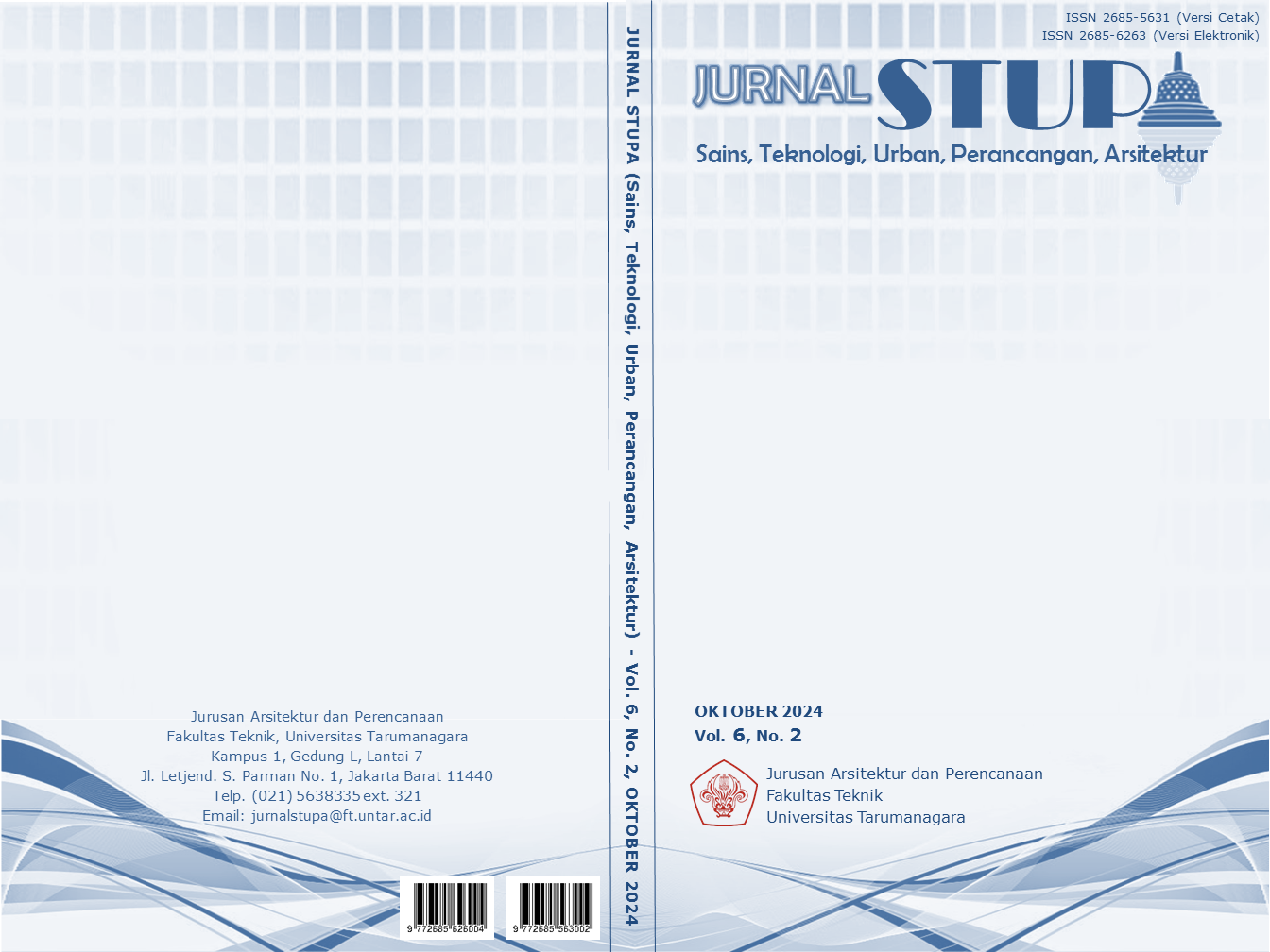PERPADUAN IDENTITAS LOKAL DAN GLOBAL PADA DESAIN PASAR KULINER BENDUNGAN HILIR
Main Article Content
Abstract
Globalization, commercialization and mass communication have brought cultural and geographical homogenization into urban space, giving rise to the term placeless place, namely the reduction of the unique characteristics and identity of a place. One of the places experiencing this phenomenon is the market and Bendungan Hilir Area. Bendungan Hilir Market, which was founded in 1972, used to have the meaning of a "place" with historical value and regional character. However, as time goes by, the value of this “place” disappears due to the influence of globalization. Now, Bendungan Hilir Market is considered less relevant and no longer able to accommodate the needs of the community, resulting in the loss of the value of authenticity, uniqueness and community connection to the market, resulting in a placeless place process. Referring to this background, there is a problem regarding the architectural completion of placeless place at Bendungan Hilir Market. Therefore, the aim of this design is to revive identity, historical ties, and community connections in the current context of globality. The design approach used is the cross-programming and contextual method through spatial experience with the traditional culinary market, meeting hub and supporting mixed use program activity stages. The traditional culinary market is a space that accommodates the main potential in the Bendungan Hilir area, namely as a culinary and commercial area. The meeting hub is the meeting center for the cities of Jakarta and Bendungan Hilir. As well as, supporting the mixed use program to accommodate community activities and services. This stage of activity will be a bond between the local community of Bendungan Hilir, and the global city of Jakarta environment, by creating a sense of place that is integrated with a mix of local and global identity elements.
Keywords: globality; locality; traditional culinary market; placeless place
Abstrak
Globalisasi, komersialisasi, dan komunikasi massa telah membawa homogenisasi budaya dan geografis ke dalam ruang kota, memunculkan istilah placeless place, yaitu berkurangnya karakteristik dan identitas unik suatu tempat. Salah satu tempat yang mengalami fenomena ini adalah pasar dan kawasan Bendungan Hilir. Pasar Bendungan Hilir, yang berdiri sejak tahun 1972, dulunya memiliki makna sebagai "place" dengan nilai sejarah dan karakter kawasan. Namun, seiring waktu, nilai "place" ini menghilang karena pengaruh globalisasi. Kini, Pasar Bendungan Hilir dinilai kurang relevan dan tidak lagi mampu mewadahi kebutuhan masyarakatnya, mengakibatkan hilangnya nilai keaslian, keunikan, dan koneksi masyarakat terhadap pasar tersebut, sehingga mengalami proses placeless place. Mengacu pada latar belakang tersebut, terdapat permasalahan bagaimana penyelesain arsitektural placeless place pada Pasar Bendungan Hilir. Oleh karena itu, tujuan dari desain ini adalah untuk menghidupkan kembali identitas, ikatan historis, dan koneksi masyarakat dengan konteks globalitas sekarang ini. Pendekatan desain yang digunakan adalah metode cross-programming dan contextual melalui pengalaman ruang dengan tahapan aktivitas traditional culinary market, meeting hub serta supporting mixed use program. Traditional culinary market merupakan ruang yang mengakomodasi potensi utama di kawasan Bendungan Hilir yaitu sebagai kawasan kuliner dan komersial. Meeting hub menjadi pusat pertemuan kota Jakarta dan Bendungan Hilir. Serta, supporting mixed use program untuk mewadahi kegiatan serta pelayanan masyarakat. Tahapan aktivitas ini akan menjadi pengikat antara masyarakat lokal Bendungan Hilir, dengan lingkungan Globalitas Kota Jakarta, dengan menciptakan sense of place yang terintergrasi dengan perpaduan unsur identitas lokal dan global.
Article Details

This work is licensed under a Creative Commons Attribution-NonCommercial-ShareAlike 4.0 International License.
This work is licensed under a Jurnal Sains, Teknologi, Urban, Perancangan, Arsitektur/ STUPA Creative Commons Attribution-NonCommercial-ShareAlike 4.0 International LicenseReferences
Arianty, N. (2013). Analisis Perbedaan Pasar Modern dan Pasar Tradisional Diinjau dari Strategi Tata Letak dan Kualitas Pelayanan untuk meningkatakan Posisi Tawar Pasar Tradisional. Jurnal Manajemen & Bisnis Vol. 13 No, 1.
Bhowmik, S. S. (2012). Street vending in Ten Cities in India. Mumbai:Tata Institute of Social Sciences.
Engel, F. J. (2020). Perilaku Konsumen. Jakarta: Binarupa Aksara.
Horn, P. (2018). Street Vendor Licensing and Permits – Reflections from StreetNet International. WIEGO, 10. Retrieved from https://www.wiego.org/sites/default/files/publications/files/Horn-WIEGOResource-Document-10.pdf (Diakses pada 23 April 2024)
Kellner, D. (2004). Globalization and The Postmodern Turn'. Los Angeles: UCLA.
Meigs, A. (2015). Food and Culture: Food as a Cultural Construction. New York: Routledge.
Relph, E. (1976). Place and Placeless. London: Pion Limited.
Robertson, R. (1992). Globalization: Social Theory and Global Culture. London: Sage.
Tuan, Y.-F. (1977). Space and Place: The Perspective of Experience. Minnesota, US: University of Minnesota Press.



